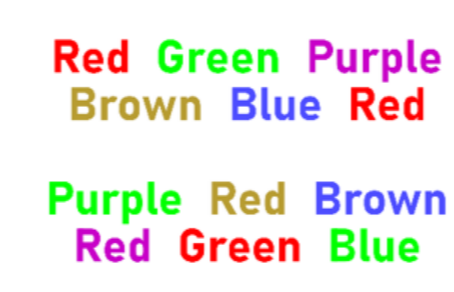AP Psych Unit 2.1
1/87
There's no tags or description
Looks like no tags are added yet.
Name | Mastery | Learn | Test | Matching | Spaced |
|---|
No study sessions yet.
88 Terms
Sensation (brain)
the process where our brain receives input from the environment through our 5 senses. Refers to the physical stimulation of the sensory receptors.
taste, smell, touch, hearing, sight
The 5 senses are taking in the world. Name the 5 senses.
perception (mind)
The process where our mind interprets the sensory input. Your mind makes sense of all that stimuli.
face blindness
Prosopagnosia is known as what?
prosopagnosia
An inability to recognize familiar faces, including one's own face, while other aspects of visual processing and intellectual functioning are not impacted.
Problems with perception.
What causes prosopagnosia? Hint: something in the brain is not allowing the senses to be recognized
Blindsight
A condition that enables someone who is blind to unconsciously perceive stimuli taken in through the eyes. Subjects have no awareness, but their brains can see it.
occipital lobe damage
Blindsight is due to...
Better understand how the visual cortex works to develop therapies to help people with visual cortex damage.
Why is blindsight important
Bottom-up processing
Starting with the sensory input, the brain interprets the stimuli. We first notice the individual elements and then create the larger picture. Inductive reasoning.
Inductive reasoning
Something specific to something general, Taking in information, then building towards what it is.
Top-down processing
When we draw on past information to process what we see. This processing draws on prior information to makes sense of the stimuli. Deductive reasoning.
Deductive reasoning
Something general to something specific.
attention
interaction between sensation and perception that is affected by both internal and external factors
selective attention, inattentional blindness, change blindness
What are the types of attention
selective attention
Our ability to focus our attention on select stimulus while filtering out other stimuli. Making decision of where I want to focus my attention.
cocktail party effect
When in a conversation with lots of noise our selective attention can be drawn away when we hear our name. We select what we perceive as important.
inattentional blindness
Failing to see objects when our attention is distracted elsewhere.
Change Blindness
Failing to notice changes in the environment when attention is directed elsewhere.
transduction
The process of turning environmental stimuli into neural impulses to send to the brain. Electrochemical process. Stimulus energy to sensory receptors to neural impulses to brain.
eyes-light waves, ears-sound waves, nose-gaseous chemical molecules, tongue-chemical molecules, skin-pressure
Transduction of eyes, ears, nose, tongue, skin
thresholds
The minimum level at which a given sense can be detected.
absolute threshold
The minimum amount of stimulus needed to detect a stimulus (half the time). Ex: Mosquito Ring Tones
signal detection theory
Assumes there is no absolute threshold that applies to everyone. It depends on the strength but also our alertness, physiology etc.
Difference Thresholds
Just noticeable difference. The minimum difference between two stimuli required for detection (50% of the time). Weber's Law. Ex: watching netflix
stroop effect

the smallest change that a person can detect
What is the just noticeable difference?
Weber's Law
To notice the difference, the difference must vary by a constant percentage not a constant amount.
sensory adaptation
our senses adapt to our surroundings. Reduction in sensitivity to a stimulus after constant exposure to it. It frees our attention to focus on other stimuli in the environment.
Sensory adaptation vision
What is this an example of: Focus on red dot in the center of a circle and the blue circle will disappear.
Internal Influence
This is based on our prior experience. Perpetual Set.
External Influence
The surrounding can alter perception due to context. Context, culture, emotion.
Perceptual set
Cognitive bias that effects the way people interpret things based on their expectation and past experience. We perceive things because off our own expectations.
Context
The surroundings can alter perception. Ex: the picture of the young girl/old woman in the bonnet.
culture
what is this an example of: What is above the woman's head? Picture has a window over the head inside for westerners; however, east African countries/Asia, would see it as outside with a gazebo or canopy with a dog (so outside) with a picture on her head balancing for windows are rare.
emotion
Can influence the way we perceive information. Reality is not reality, it is what we think it is. We create our reality by what we want to see. Ex: Hearing sad music can predispose people to perceive a sad meaning in words that sound alike... mourning rather than mourning, die rather than dye, pain rather than pane. Ex: Loch ness monster or curved log.
electromagnetic energy
The air around us is filled with waves of
visible spectrum
What is the part of electromagnetic energy that our eye can process? (to see this electromagnetic energy humans must have a light source)
color; intensity
Light waves: Frequency (wavelength) gives us __________ (hue). Amplitude (height) gives us ___________.
lens
The transparent piece behind the pupil that changes shape to help focus images on the retina.
accommodation
Process of changing the curvature (shape) of the lens to focus light on the retina.
nearsightedness (see near)
the lens focuses the image in front of the retina
farsightedness (see far)
The lens focusing light past the retina
the back surface of the eye
Where is the retina located?
rods and cones
The retina contains the light-sensitive receptors called __________ and __________.
transduction
The retina begins the processing of ________________.
rods
Rods or Cones: black and white
rods
Rods or Cones: sensitive to movement
rods
Rods or Cones: peripheral vision and twilight vision
rods
Rods or Cones: lack clarity
cones
Rods or Cones: photo receptors concentrated at the center of the retina (fovea)
cones
Rods or Cones: function well in daylight
cones
Rods or Cones: fine detail and color
ganglion cells
What are the outer cells of the retina that light must contact?
fovea
Central point in the retina, where cones are clustered. Greatest visual clarity.
optic nerves
It leaves through the back of the eye and carries the neural impulses to the brain.
blind spot
Hole where the optic nerve leaves the eye. No photoreceptors are located here. Brain fills in the gap (hole) to complete the picture of the world.
light waves; neural impulses; visual cortex; perception
Neural Impulses Leave the Eye: Pupil allows ________________ into eyes. Optic nerve sends ______________ to the brain. Thalamus directs the signal to the ______________. ______________ occurs.
color vision
Color is a mental construction; light rays are not colored.
Trichromatic theory and Opponent Process theory
What are the 2 theories on how we see colors?
Trichromatic theory
The retina contains 3 types of cones. Red-long wavelength, green-medium wavelength, blue-short wavelength. When stimulated in combination, these 3 types of cones produce the perception of any color. All cones reacting equally create white but if none are reacting it creates black.
opponent process theory
the theory that cones are paired together to enable color vision. Red with green, blue with yellow, white with black.
After image effect
When certain ganglion cells in the retina are activated. Black gets tired you see white, green gets tired you see red, yellow gets tired you see blue.

dichromatic and monochromatic
What are the two types of color vision deficiency (color blindness)?
Dichromatic
when a person can't see a certain set of two colors (red and green)
monochromatic
When a person can't see any color and only see the world in black and white.
Touch is not triggered by one stimulus. Touch is a mix of thousands of nerve endings in the skin. The skin sensors respond to what 4 basic sensations?
pressure, pain, warm, cold (Ex: tickle = pressure and pain)
the body and the brain
Pain is felt in the __________ and the ____________.
The spinal cord contains a “gate” that either blocks or allows pain signals to the brain. Ex: The girl who feels no pain. Little girl feels no pain because small fibers aren’t working.
Gate Control Theory (details on slide 4)
The Brain: each person experiences pain differently=perception. When do people feel “less” pain?
Distracted (humor), Focused (athletes), Placebos
Phantom limb pain
People who have lost a limb report feeling in the limb that used to be there. They often report pain.
What is gustation?
the sense of taste
Have hair-like receptors that catch chemical molecules and transduce to neural messages for the brain.
Taste buds (pores)
What happens to taste buds with age?
Fewer taste buds are created so we become less sensitive to taste (children are pickier eaters)
5
New taste buds are created every ______ days
Genetic difference in our ability to taste food (3)
Supertaster, medium taster, nontaster
Name the 6 taste sensations.
Sweet, salty, sour, bitter, umami, oleogustus
is a meaty taste associated with meats, cheeses, soy, seaweed, and mushrooms
Umami (savory)
Bitter saves us from _________
toxin
Oleogustus is the taste of _______
fat
Nostrils take in chemical molecules. Different chemical molecules fit into different receptor cells in the nose. Then to ____________.
Olfactory Bulb (Bypasses Thalamus)
Pheromones
Chemical substances secreted by animals that have an effect on behavior within their own species.
mating, aggression, and communication
Pheromones are signals influencing what 3 things?
Vestibular Sense (Ex: riding a bike, gymnasts)
Controls balance which is detected in the semicircular canals (in the inner ear). The information is sent to the cerebellum.
The sense of one’s body movement. Position and motion detectors, located in muscles and joints, sense the position and movement of body parts.
Kinesthetic sense
What would happen if we didn’t have kinesthetic sense?
we would need to watch our limbs to coordinate our movement
Sensory interaction (Taste is dependent upon smell, like when you have a cold. Smells evoke powerful memories, olfactory bulb near hippocampus.)
when different senses influence one another
A condition when one system of sensation is experienced through another. Ex: every time you hear car, you taste peanut butter.
synesthesia